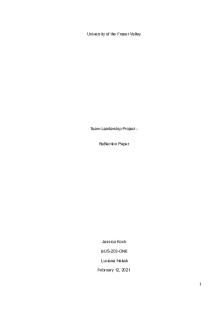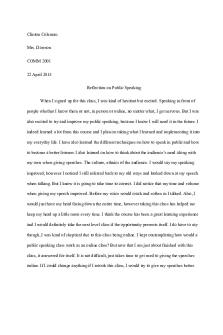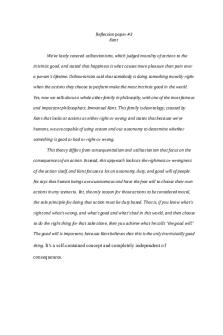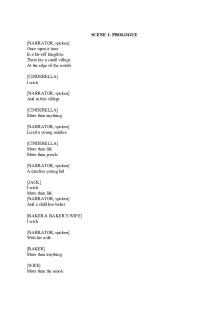Into the Woods Reflection Paper PDF

| Title | Into the Woods Reflection Paper |
|---|---|
| Course | Theatre History III |
| Institution | The City College of New York |
| Pages | 3 |
| File Size | 48 KB |
| File Type | |
| Total Downloads | 61 |
| Total Views | 153 |
Summary
Reflection on the play Into the Woods....
Description
Leticia Mendoza Theatre History III 21300 Prof. Chloë Edmonson Into the Woods Reflection Paper While I watched Into the Woods I couldn’t help but relate the premise of the play to not one, but three of the topics we’ve discussed in class. I noticed moments of Avant-garde, Absurdism, and even the Brechtian v-effect. When it comes to reflecting back on what I witnessed it becomes difficult to narrow the entire play to one category of discussion from the semester. Into the Woods is very Avant-garde in the sense that every song is a spectacle and larger than life. The witch’s costume in particular was very avant-garde. In the beginning of the play the witch wore a crow’s mask, a cloak, and used two wooden poles to walk. Eventually she’d change into a corseted sparkly outfit. The songs that are sung in the play are bursting with energy and create a spectacular fairytale world. Moments of Absurdism are hard to miss when watching Into the Woods. A key moment of Absurdism is the Baker and his wife believing that these magic beans will help them have a child of their own. I think this a great reflection on the human condition, being that most people believe money or some type of currency will fix their issues in life. The Baker’s Wife also tries to steal Rapunzel’s hair and Cinderella’s shoe which would be considered an absurd thing to believe that these items will help you bear a child. Another moment of absurdism is the ‘cow’ which I found very amusing. I’d consider the method of an actor in a subtle cow costume to be absurdist. The actor who portrayed the cow, carries a cow head, he also carries a basket that has the cows utters attached and chews like a cow as well. At the same time, this can leave a lot up to the imagination of the audience. In one scene in which the cow dies, the actor carrying the cow
attire drops everything, shrugs his shoulders and exits. This had to be one of the favorite comedic scenes. Eventually the cow would be played by the actress who portrays Little Red Riding Hood. The actress playing Rapunzel also played the role of Jack’s harp which I found to be absurdist because it didn’t really add much to the storyline, minus the fact that we have a person playing an inanimate object. Absurdist plays include aimless dialogue. Actors could also be seen walking back and forth past each other in a rush, reciting lines without any deep meaning or substance. To top everything off, I took note of numerous examples of Brecht’s V-effect. I always think its so funny when a character whether it’d be on TV, a movie or a play, acknowledges that they’re in a story, which the characters of Into the Woods did a lot of. In the scene where Cinderella’s Prince starts to sing to the Baker’s Wife, she asks if she’s in the wrong story. I thought this to be very Bretchian, in the sense that it takes you out of the play for a second and reminds you that you’re watching a story unfold. In one scene when the giant was threatening everyone over the loss of her husband, the characters sacrifice the Narrator. When this happens, he says that in doing so, they will not know how the story ends. I found this to be another nod to the Brechtian style of plays. A subtle reminder that the audience is still in a theatre watching a story play out. The songs in the play also narrate the inner workings of the character and plots of each scene. Their thoughts, emotions and motives are all explained in detail, within the songs that they sing. This keeps the audience from getting too attached to the story and thinking too in depth about the moments occurring on stage. The Narrator, is also very similar to the Singer character that we’ve seen in Brecht’s Caucasian Chalk Circle. When the Narrator is on stage, he is not just simply narrating. He is also providing the audience with a Brechtian V-effect experience. An experience in which they are reminded that they are watching a play by the shear fact that someone is
explaining the events taking place, thus letting the audience sit back, relax, watch and not worry about having to think too critically about what’s going on....
Similar Free PDFs

Into the Woods Reflection Paper
- 3 Pages

Reflection Paper
- 2 Pages

Reflection Paper
- 4 Pages

Reflection Paper
- 2 Pages

Reflection paper
- 3 Pages

Reflection paper for pino
- 2 Pages

Conflict Reflection Paper
- 8 Pages

Haudenosaunee reflection paper
- 3 Pages

Reflection paper rubric 05
- 1 Pages

Managment Reflection Paper
- 12 Pages

Reflection Paper chapter 5
- 1 Pages
Popular Institutions
- Tinajero National High School - Annex
- Politeknik Caltex Riau
- Yokohama City University
- SGT University
- University of Al-Qadisiyah
- Divine Word College of Vigan
- Techniek College Rotterdam
- Universidade de Santiago
- Universiti Teknologi MARA Cawangan Johor Kampus Pasir Gudang
- Poltekkes Kemenkes Yogyakarta
- Baguio City National High School
- Colegio san marcos
- preparatoria uno
- Centro de Bachillerato Tecnológico Industrial y de Servicios No. 107
- Dalian Maritime University
- Quang Trung Secondary School
- Colegio Tecnológico en Informática
- Corporación Regional de Educación Superior
- Grupo CEDVA
- Dar Al Uloom University
- Centro de Estudios Preuniversitarios de la Universidad Nacional de Ingeniería
- 上智大学
- Aakash International School, Nuna Majara
- San Felipe Neri Catholic School
- Kang Chiao International School - New Taipei City
- Misamis Occidental National High School
- Institución Educativa Escuela Normal Juan Ladrilleros
- Kolehiyo ng Pantukan
- Batanes State College
- Instituto Continental
- Sekolah Menengah Kejuruan Kesehatan Kaltara (Tarakan)
- Colegio de La Inmaculada Concepcion - Cebu




